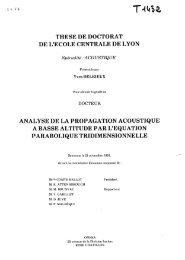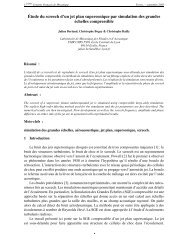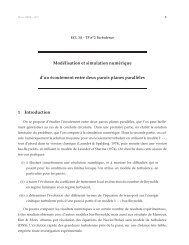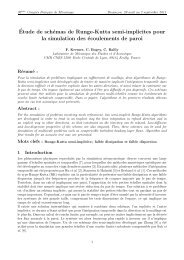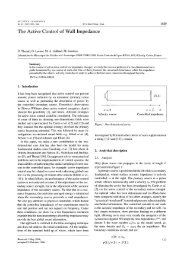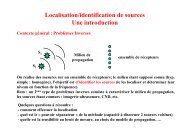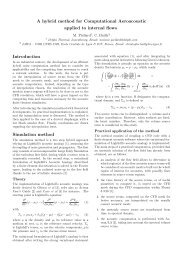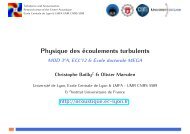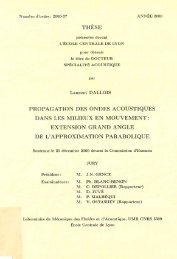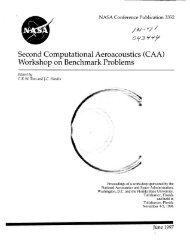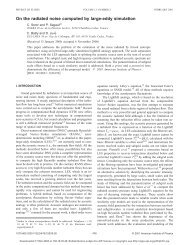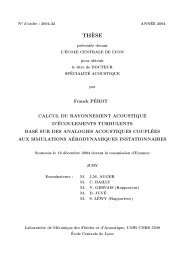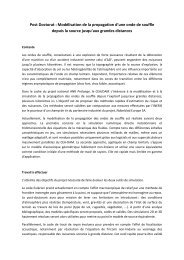ERCOFTAC Bulletin - Centre Acoustique
ERCOFTAC Bulletin - Centre Acoustique
ERCOFTAC Bulletin - Centre Acoustique
Create successful ePaper yourself
Turn your PDF publications into a flip-book with our unique Google optimized e-Paper software.
Impact of Inhomogeneous Density Distribution on<br />
Acoustic Sources in Turbulent Jets<br />
Abstract<br />
S. R. Koh 1 , G. Geiser 1 , H. Foysi 2 and W. Schröder 1<br />
1 Institute of Aerodynamics RWTH Aachen University,<br />
Wüllnerstraße 5a, D-52062 Aachen, Germany, s.koh@aia.rwth-aachen.de<br />
2 University of Siegen, Paul-Bonatz-Straße 9-11, D-57068 Siegen, Germany<br />
The noise generation of a helium-mixture and a hot-air<br />
coaxial jet is analyzed by a hybrid large-eddy simulation<br />
(LES) acoustic perturbation equations (APE) method.<br />
The coaxial jet configuration defined by a strong density<br />
gradient at the nozzle exit serves as a test problem<br />
to show the impact of the formulation of the entropy<br />
source terms on the acoustic field. To be more precise,<br />
in the APE-4 formulation a linearization of the second<br />
law of the thermodynamics is dropped and a new formulation<br />
based on the excess density is introduced. The<br />
novel source term remedies the deficit of the high-order<br />
source contribution which introduces an overestimate of<br />
low frequency acoustics.<br />
1 Introduction<br />
Non-uniform density distributions play an important role<br />
in the propagation of sound. The refraction of sound due<br />
to a pronounced temperature gradient is just one example.<br />
As indicated by Tester and Morfey [1] the mean density<br />
gradient partially accounts for sound amplification in<br />
subsonic jets. The sound mechanism contains additional<br />
sources in the unsteady density field, i.e., the acoustic radiation<br />
from a sheared mean flow is amplified by scattering<br />
from the mean density gradient [2]. An experimental<br />
measurement concerning the role of mass diffusion in a<br />
gas mixture [3] indicated a strong increase of acoustic<br />
damping by helium and nitrogen dioxides when the local<br />
density field was disturbed. Goldstein [4] showed that<br />
there is an exact analogy between the acoustic source<br />
in a real flow and the linear inviscid fluctuations of a<br />
quadrupole plus a temperature dipole source in an arbitrary<br />
ideal sheared mean flow. However, the identification<br />
of real sources in realistic turbulent flows is hard to<br />
achieve since the sound generation is only a small energy<br />
fraction of the entire fluid dynamic process.<br />
It goes without saying that there exists a vast amount<br />
of literature on single-jet noise whereas just a few papers<br />
on coaxial jets have been published compared to the<br />
single-jet problem. In general, the analysis of coaxial-jet<br />
noise is based on the knowledge of single jets. In an extension<br />
of this approach the effect of multiple shear layers<br />
has been considered by Morfey and Tester [5] to correct<br />
the attenuation of sound and to discuss the scattering<br />
of sources in the shear layer. Later, more systematic<br />
analyses on heated and/or unheated primary flow configurations<br />
have been performed by considering dipole<br />
and quadrupole sources which depend differently on the<br />
turbulence intensity [6, 7]. That is, some knowledge on<br />
the impact of density gradients on the acoustics of coaxial<br />
jets is available. Recently, Koh et al. [8] showed the<br />
spectral density distributions of the entropy sources to<br />
form a cone-like surface being wrapped around the end<br />
of the potential core and the acoustic core characterized<br />
by the entropy source terms to generate low frequency<br />
dipole sound. However, the picture on the sound generation<br />
process and the importance of density gradient<br />
driven sources is by far not complete. To get further insight<br />
in the sound generation and propagation in multiple<br />
shear layer jets possessing an inhomogeneous density distribution<br />
either due to density or temperature gradients<br />
further experimental and numerical analyses are necessary.<br />
In these numerical models as little assumptions<br />
as possible should be used to have a formulation that is<br />
valid for a wide class of configuration. This problem is<br />
addressed in this contribution by introducing a formulation<br />
of the entropy related source terms that is based on<br />
the excess density.<br />
To compute the jet acoustic field at various thermodynamic<br />
properties a hybrid large-eddy simulation/computational<br />
aeroacoustics (LES/CAA) approach<br />
is applied. That is, a two-step method using large-eddy<br />
simulation for the flow field and acoustic perturbation<br />
equations (APE) for the acoustic field is used [9]. Since<br />
a multi-species gas flow is tackled the acoustic source<br />
terms are formulated to contain the effects of mass diffusion<br />
and the thermal properties are accounted for in<br />
the local speed of sound. The source terms in the APE<br />
formulation are related to certain noise generation mechanisms<br />
and thus, it is possible to analyze the acoustic<br />
sources in great detail. Using the noise source terms of<br />
the acoustic perturbation equations for a compressible<br />
fluid the acoustic field is analyzed by considering, e.g.,<br />
power spectra and overall sound pressure level distributions.<br />
The organization of the paper is such that first, the<br />
acoustic perturbation equations and the new entropysource<br />
formulation are presented, then the numerical approach<br />
is briefly outlined, and the results are discussed<br />
after the flow configurations are introduced.<br />
2 Numerical method<br />
2.1 Acoustic governing equations<br />
The original APE-4 system [9] reads<br />
∂p ′<br />
∂t + a2 <br />
∇ · ρu ′ + u p′<br />
a ′<br />
<br />
∂u ′<br />
∂t + ∇ (u · u′ ′ p<br />
) + ∇<br />
ρ<br />
= −a 2 qc (1)<br />
= qm , (2)<br />
<strong>ERCOFTAC</strong> <strong>Bulletin</strong> 90 15



